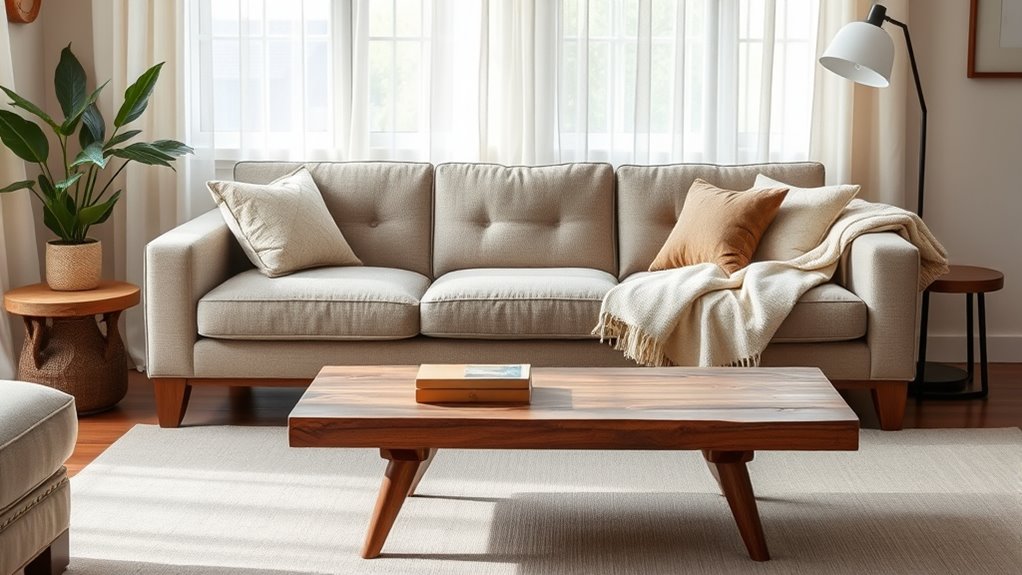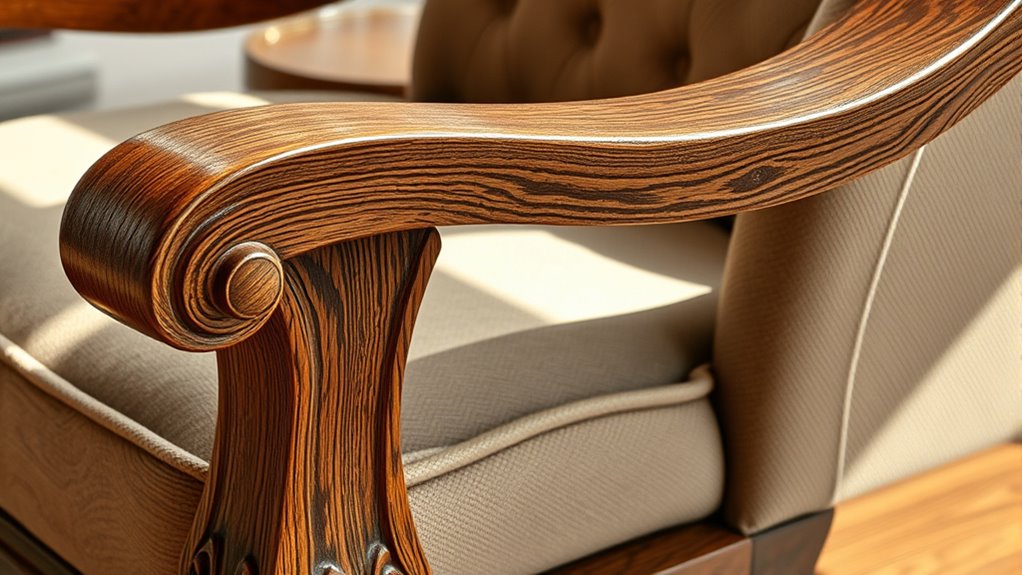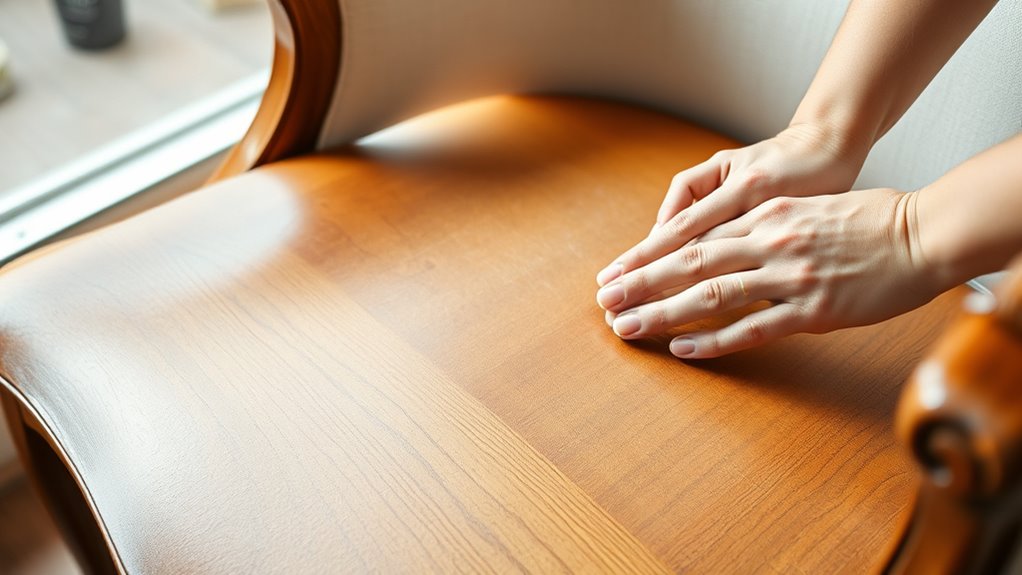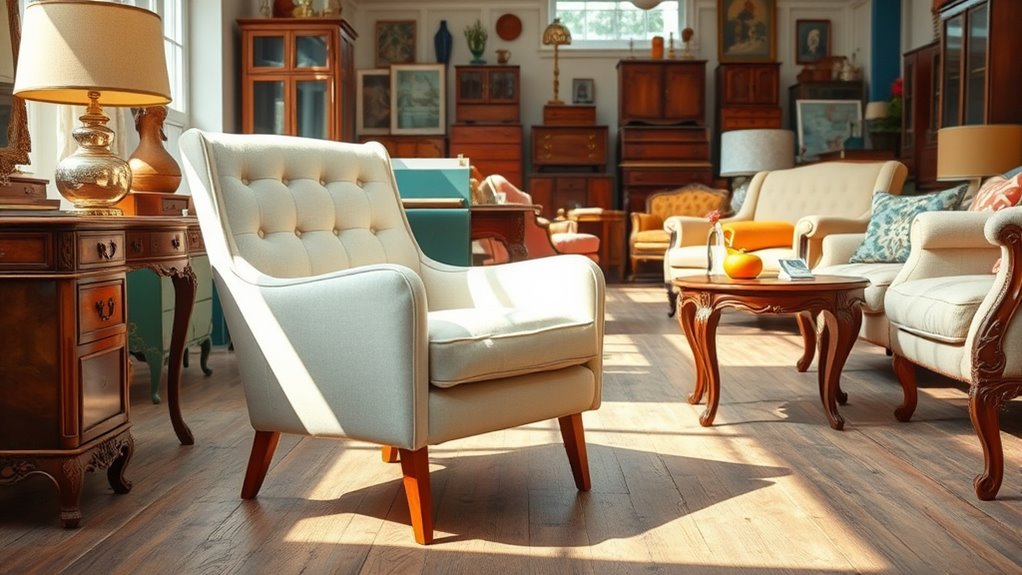To guarantee second-hand furniture looks new, start by inspecting the surface for scratches, dents, or uneven paint, and feel for rough patches. Check for hidden damage or past repairs in seams, joints, and hidden corners with a flashlight. Stick to timeless, neutral styles that won’t quickly go out of fashion, and prioritize pieces made from quality materials with sturdy craftsmanship. Finally, clean and refinish surfaces or update hardware to give your furniture a fresh, renewed appearance—there’s more to discover if you continue.
Key Takeaways
- Carefully inspect for surface flaws, uneven finishes, and hidden damage using good lighting and tactile checks.
- Focus on timeless, neutral styles that remain versatile and less affected by changing trends.
- Prioritize furniture made from high-quality materials with sturdy craftsmanship for durability.
- Verify joints, seams, and hidden areas for signs of past repairs or structural issues.
- Clean, refinish, or update hardware to refresh the piece and ensure a like-new appearance.
Inspect the Surface and Finish Carefully

When inspecting second-hand furniture, paying close attention to the surface and finish can reveal a lot about its condition. Look for surface flaws like scratches, dents, or chips, which might indicate rough handling or wear. Paint inconsistencies, such as uneven color, drips, or areas where the finish is peeling, can also signal poor quality or previous repairs. These imperfections don’t always mean the piece is unusable, but they can affect its appearance and longevity. Use good lighting to catch subtle flaws, and run your hand over the surface to feel for rough patches or irregularities. Addressing surface flaws early helps you decide if the furniture needs refinishing or touch-ups, ensuring you get a piece that looks good and lasts. Additionally, examining the finish quality can help determine if the piece has been properly maintained or if it might require refinishing to restore its original look.
Look for Hidden Damage or Repairs

Even if a piece looks perfect on the surface, verifying for hidden damage or repairs that might not be immediately visible is vital. Check for hidden stains that may have been cleaned or covered up, as they can indicate underlying issues. Examine joints, seams, and the underside for signs of past repairs, such as uneven surfaces, mismatched paint, or glued areas. Use a flashlight to inspect crevices and hidden corners where damage can hide. Tap or press gently on the furniture to detect soft spots or weak spots that suggest structural repairs. Be especially cautious with older pieces, as hidden damage can compromise durability and value. Additionally, understanding automation in business can help you appreciate the importance of thorough inspection and maintenance to ensure long-lasting quality. Taking these steps helps guarantee you’re investing in furniture that genuinely looks new and is structurally sound.
Focus on Timeless, Neutral Styles

Choosing furniture in timeless, neutral styles guarantees your pieces remain versatile and stylish for years to come. A neutral palette, with shades like beige, gray, or soft whites, easily blends with various décor and color schemes, making it simple to refresh your space. Focus on vintage charm that offers classic lines and subtle details, which tend to hold their appeal longer than trendy designs. These styles tend to be more resilient to changing interior trends, ensuring your furniture stays relevant over time. By selecting pieces with a neutral color scheme and timeless design, you can effortlessly update your home with different accessories or accents. Incorporating vetted furniture options can further ensure your pieces maintain their appearance and quality over the years. This approach not only enhances your décor’s longevity but also creates a cohesive, sophisticated look that feels fresh and inviting.
Prioritize Quality Materials and Craftsmanship

Opting for furniture made from high-quality materials and crafted with care guarantees your investment lasts. Focus on upholstery durability—test the fabric or leather to ensure it feels sturdy and wears well over time. Well-made furniture often features dense foam padding and tightly woven fabrics, which resist sagging and tearing. Pay close attention to hardware quality; sturdy, well-secured hinges and joints indicate craftsmanship. Check for smooth operation and tight-fitting parts, as cheap hardware can lead to quick damage and instability. Selecting pieces with strong frames, durable upholstery, and quality hardware ensures longevity and a better appearance. When you prioritize craftsmanship and materials, your second-hand furniture will look and feel as good as new, saving you money and hassle in the long run.
Clean and Refinish for a Fresh Look

A thorough cleaning can dramatically improve the appearance of second-hand furniture, making it look fresh and well-maintained. Start by dusting and vacuuming upholstery to remove dirt and allergens, then spot-clean stains or consider professional upholstery maintenance if needed. For wood pieces, gently sand and refinish surfaces to restore their original luster. Refinishing not only refreshes the look but also allows you to match decor seamlessly. Repainting or staining furniture can give it a new vibe, especially if the current finish is worn. Don’t forget to update hardware or fixtures to enhance the overall appearance. Additionally, incorporating sound healing techniques can create a calming atmosphere that complements your refreshed furniture. These simple steps can transform second-hand furniture into a stylish, cohesive addition to your living space, making it look almost brand new without breaking the bank.
Frequently Asked Questions
How Can I Identify Authentic Vintage Furniture From Modern Reproductions?
When spotting authentic vintage furniture, you look for authenticity markers like unique wear patterns, original hardware, and aged patina. Reproduction clues include modern screws, uniform finishes, and overly perfect details. You should examine joins and construction techniques, as vintage pieces often feature handcrafted details. Trust your instincts and compare with verified vintage items. Recognizing these authenticity markers and reproduction clues helps you confidently select genuine vintage furniture that truly stands out.
What Are the Best Places to Find High-Quality Second-Hand Furniture Deals?
You should explore local thrift stores, estate sales, and online marketplaces for the best second-hand furniture deals. Thrift store finds often offer unique pieces at great prices, especially if you know estate sale tips to negotiate and spot quality items. Always inspect furniture carefully for damage or repairs, and don’t hesitate to ask about history or provenance. With patience and a keen eye, you’ll find high-quality pieces that look fantastic without breaking the bank.
How Do I Determine the True Age and Provenance of Second-Hand Furniture?
Like Sherlock examining clues, you can determine a piece’s true age and provenance by inspecting its wood grain for patterns that reveal its history. Look for style indicators such as craftsmanship details, joinery, and hardware that match specific eras. Research furniture styles and compare. Authentic pieces often show signs of wear, consistent with their age, helping you confidently identify their origin and authenticity.
What Safety Precautions Should I Take When Inspecting and Cleaning Used Furniture?
When inspecting and cleaning used furniture, prioritize pet safety by removing any loose or broken parts that could harm your pets. Wear gloves and use gentle, non-toxic cleaning solutions to avoid exposing your pets to harmful chemicals. *Make certain* good ventilation during cleaning. Check for signs of pests or mold, and thoroughly clean all surfaces. These precautions protect both your pets and your home, making your second-hand furniture safe and clean.
How Can I Effectively Match Second-Hand Furniture With Existing Home Decor?
When matching second-hand furniture with your existing decor, focus on color coordination and material matching. You can start by choosing pieces that complement your current color palette or add a pop of contrast. Consider the materials—wood, metal, or fabric—to guarantee harmony. Use throw pillows, rugs, or paint to tie mismatched furniture together. This approach creates a cohesive look that makes your space feel fresh and thoughtfully curated.
Conclusion
By keeping these tips in mind, you’ll turn second-hand furniture into a fresh, stylish piece that looks brand new. Take your time to inspect, prioritize quality, and consider timeless styles to avoid future headaches. Remember, a little effort now can save you from buying a lemon later. With patience and a keen eye, you’ll find hidden gems that feel like they just rolled off the showroom floor. It’s all about making the most of what’s out there!









